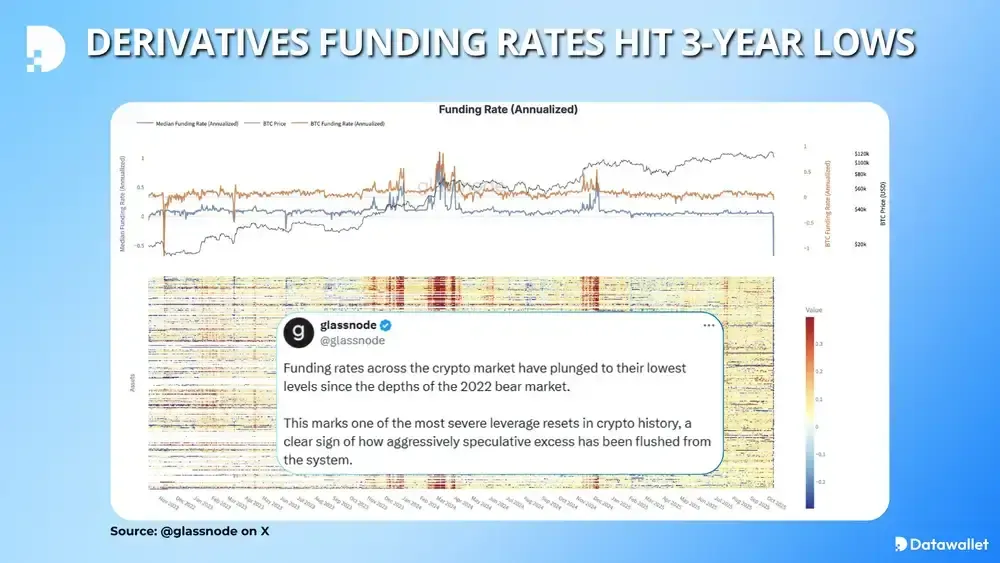Hyperliquid Activates HIP-3 for Permissionless Perps

GM. Hyperliquid activated HIP-3, allowing developers to launch permissionless perpetual futures on its Layer-1 network as HYPE jumped 11% ahead of the upgrade.
Meanwhile, Bitcoin Core’s new update reignited debate over data limits, Binance paid $283 million to cover temporary depegs, and BitMine expanded its ETH holdings past $12 billion.
Builders are deploying, miners are accumulating & markets are finding their rhythm again. 👇
Hyperliquid Activates HIP-3 for Permissionless Perps
Hyperliquid is activating HIP-3 today, a network upgrade enabling permissionless deployment of perpetual futures markets on its Layer-1 protocol. The move marks a new phase in decentralization, giving builders freedom to list markets without centralized approval.
The team confirmed the rollout in its Discord, noting HIP-3 would switch on October 13 during a scheduled system upgrade. HIP-3 integrates HyperCore and HyperEVM, ensuring new markets benefit from the chain’s existing smart contract capabilities, governance controls, and onchain execution safeguards.
Deployers must stake 500,000 HYPE to launch perpetuals, adding an entry cost that deters spam and aligns participants with network integrity. The protocol also includes validator slashing and open interest caps to limit abuse and preserve trading stability.
No immediate changes affect existing Hyperliquid users, though builders meeting requirements may begin deploying perps once ready following activation. HYPE surged 11% over 24 hours to $42, lifting the token’s market capitalization above $11.4 billion as traders positioned ahead.
Bitcoin Core v30 Update Sparks OP_RETURN Controversy
Bitcoin Core developers released version 30, introducing new privacy features and increasing OP_RETURN capacity to 100,000 bytes. The update adds node security and encrypted communication but has reignited debate among purists opposing non-financial data storage. Developers say the expanded data limit enables richer onchain applications but critics warn it risks legal exposure and network inefficiency.
Some node operators are migrating to Knots, an alternative client enforcing the legacy 80-byte cap on embedded data. Cryptographer Nick Szabo (who is one of the top candidates of being Satoshi Nakamoto) advised caution, citing risks of “illegal data” on archival nodes. Community sentiment remains divided, evoking memories of the 2017 block size wars that once split Bitcoin into rival chains.
Binance Pays $283 Million to Cover Depeg Losses
Binance compensated users with $283 million after assets in its Earn program temporarily lost their intended pegs. The exchange said futures, margin, and loan users affected by volatile prices in USDe, BNSOL, and WBETH received direct reimbursements. Executives denied claims of a targeted exploit, asserting the depegs followed a broader market downturn, not the cause.
Binance pledged additional safeguards, including soft floors and adjusted redemption weights to stabilize index pricing across Earn products. The exchange also addressed technical glitches causing extreme token mispricing on legacy limit orders. Analysts said the quick compensation reinforced Binance’s dominance but highlighted systemic fragility in algorithmic and staked-asset markets.
BitMine Adds $838 Million in Ethereum Holdings
Publicly traded miner BitMine Immersion Technologies expanded its Ethereum treasury, acquiring over 200,000 ETH valued at roughly $838 million. The Las Vegas-based company now holds more than three million ETH, accounting for about 2.5% of supply. Chairman Tom Lee said market volatility provided an “opportune discount” to accumulate long-term holdings at attractive price levels.
BitMine’s portfolio now exceeds $12.5 billion in Ethereum, alongside smaller Bitcoin and venture allocations. The firm aims to own 5% of total ETH supply as part of a diversification strategy. Investors responded positively, lifting BitMine’s stock by more than 4% amid a rebound in crypto markets, as interest in Ethereum treasuries companies increases.
Data of the Day
Crypto derivatives funding rates plunged to their lowest levels since 2022 as overleveraged positions unwound across major exchanges. Glassnode analysts described the event as one of the “most aggressive leverage resets” in market history. The decline reflected a surge in short positions, signaling widespread bearish sentiment following unprecedented liquidations.
Analysts noted that excessively negative funding rates could trigger a short squeeze if prices rebound sharply. Bitcoin and Ethereum perpetuals remain slightly negative, though spot markets have already recovered considerable ground. Observers said the massive flush reduced speculative risk and could reset conditions for a sustainable upward trend.

More Breaking News
- Crypto investment products recorded $3.17 billion in inflows last week, defying a historic $19 billion liquidation event triggered by Trump’s China tariff remarks.
- BNB token surged to an all-time high of $1,370 despite trader outrage over weekend glitches and record liquidation-driven volatility.
- China Renaissance is raising $600 million for a US-listed BNB treasury vehicle with YZi Labs, extending its partnership amid surging token demand.
- Michael Saylor's Strategy acquired 220 BTC at $123,561 each, missing cheaper entry points below $110,000 during last week’s market collapse and flash crash.
- The Dogecoin Foundation’s corporate arm, House of Doge, began Nasdaq trading via Brag House Holdings to expand Dogecoin’s role in global payments.
- Jeff Yan, Hyperliquid's founder, accused major centralized exchanges of underreporting liquidation data by up to 100x during recent market chaos.
- BlackRock CEO Larry Fink said Bitcoin and crypto now “serve the same purpose as gold,” marking a complete reversal from his 2017 remarks.
For the latest updates on digital asset markets, follow us on X @Datawalletcom.
.webp)
Written by
Jed Barker
Editor-in-Chief
Jed, a digital asset analyst since 2015, founded Datawallet to simplify crypto and decentralized finance. His background includes research roles in leading publications and a venture firm, reflecting his commitment to making complex financial concepts accessible.







